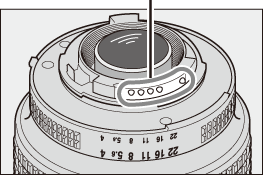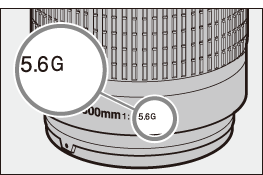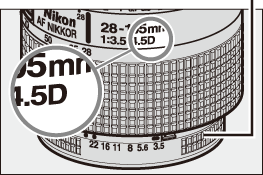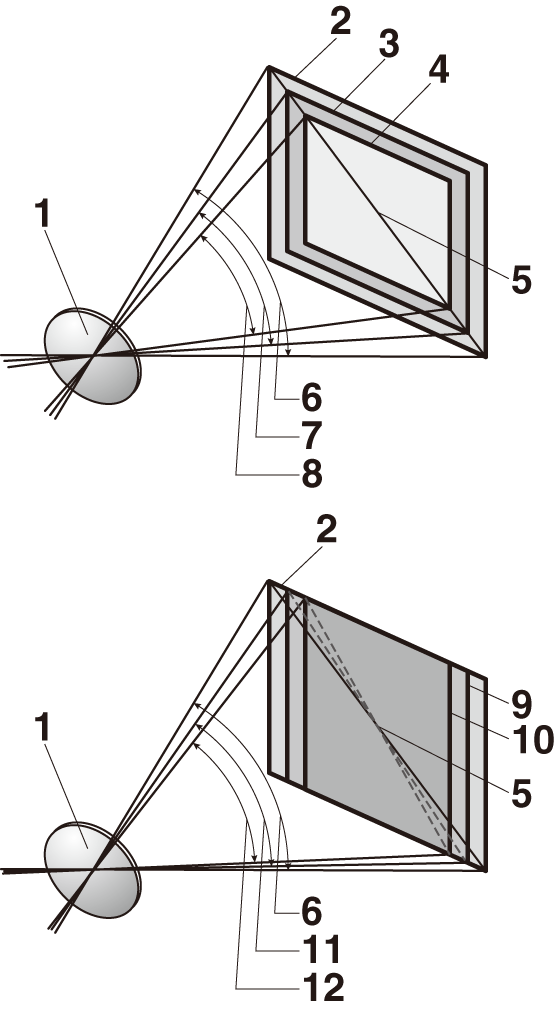Compatible Lenses
(PDF; 44.4 KB)
Recognizing CPU and Type G, E, and D Lenses
CPU lenses (particularly types G, E, and D) are recommended, but note that IX-NIKKOR lenses cannot be used. CPU lenses can be identified by the presence of CPU contacts, type G, E, and D lenses by a letter on the lens barrel. Type G and E lenses are not equipped with a lens aperture ring.
CPU contacts

CPU lens

Type G/E lens
Aperture ring

Type D lens
Lens f-number
The f-number given in lens names is the maximum aperture of the lens.
Compatible Non-CPU Lenses
Non-CPU lens data (0 Non-CPU Lenses) can be used to enable many of the features available with CPU lenses, including color matrix metering; if no data are provided, center-weighted metering will be used in place of color matrix metering, while if the maximum aperture is not provided, the camera aperture display will show the number of stops from maximum aperture and the actual aperture value must be read off the lens aperture ring.
Incompatible Accessories and Non-CPU Lenses
The following cannot be used with the D850:
- TC-16A AF teleconverter
- Non-AI lenses
- Lenses that require the AU-1 focusing unit (400mm f/4.5, 600mm f/5.6, 800mm f/8, 1200mm f/11)
- Fisheye (6mm f/5.6, 7.5mm f/5.6, 8mm f/8, OP 10mm f/5.6)
- 2.1cm f/4
- Extension Ring K2
- 180–600mm f/8 ED (serial numbers 174041–174180)
- 360–1200mm f/11 ED (serial numbers 174031–174127)
- 200–600mm f/9.5 (serial numbers 280001–300490)
- AF lenses for the F3AF (AF 80mm f/2.8, AF 200mm f/3.5 ED, AF Teleconverter TC-16)
- PC 28mm f/4 (serial number 180900 or earlier)
- PC 35mm f/2.8 (serial numbers 851001–906200)
- PC 35mm f/3.5 (old type)
- Reflex 1000mm f/6.3 (old type)
- Reflex 1000mm f/11 (serial numbers 142361–143000)
- Reflex 2000mm f/11 (serial numbers 200111–200310)
VR Lenses
The lenses listed below are not recommended for long exposures or photographs taken at high ISO sensitivities, as due to the design of the vibration reduction (VR) control system the resulting photos may be marred by fog. We recommend turning vibration reduction off when using other VR lenses.
- AF-S VR Zoom-Nikkor 24–120mm f/3.5–5.6G IF-ED
- AF-S VR Zoom-Nikkor 70–200mm f/2.8G IF-ED
- AF-S VR Zoom-Nikkor 70–300mm f/4.5–5.6G IF-ED
- AF-S VR Nikkor 200mm f/2G IF-ED
- AF-S VR Nikkor 300mm f/2.8G IF-ED
- AF-S NIKKOR 16–35mm f/4G ED VR
- AF-S NIKKOR 24–120mm f/4G ED VR
- AF-S NIKKOR 28–300mm f/3.5–5.6G ED VR
- AF-S NIKKOR 400mm f/2.8G ED VR
- AF-S NIKKOR 500mm f/4G ED VR
- AF-S DX VR Zoom-Nikkor 18–200mm f/3.5–5.6G IF-ED
- AF-S DX NIKKOR 16–85mm f/3.5–5.6G ED VR
- AF-S DX NIKKOR 18–200mm f/3.5–5.6G ED VR II
- AF-S DX Micro NIKKOR 85mm f/3.5G ED VR
- AF-S DX NIKKOR 55–300mm f/4.5–5.6G ED VR
Calculating Angle of View
The camera can be used with Nikon lenses for 35 mm (135) format cameras. If a 35 mm format lens is attached, the angle of view will be the same as a frame of 35 mm film (35.9 × 23.9 mm).
If desired, the Image area option in the photo shooting menu can be used to choose an angle of view different from that of the current lens. If a 35 mm format lens is attached, you can reduce the angle of view by 1.5× or 1.2× by selecting DX (24×16) or 1.2× (30×20) to expose a smaller area, or change the aspect ratio by selecting 5 : 4 (30×24) or 1 : 1 (24×24). The sizes of the areas exposed by different Image area options are shown below.

| 1 | Lens |
|---|---|
| 2 | FX (36×24) picture size (35.9 × 23.9 mm, equivalent to 35 mm format camera) |
| 3 | 1.2× (30×20) picture size (29.9 × 19.9 mm) |
| 4 | DX (24×16) picture size (23.5 × 15.7 mm, equivalent to DX format camera) |
| 5 | Picture diagonal |
| 6 | Angle of view (FX (36×24); 35 mm format) |
| 7 | Angle of view (1.2× (30×20)) |
| 8 | Angle of view (DX (24×16); DX format) |
| 9 | 5 : 4 (30×24) picture size (29.9 × 23.9 mm) |
| 10 | 1 : 1 (24×24) picture size (23.9 × 23.9 mm) |
| 11 | Angle of view (5 : 4 (30×24)) |
| 12 | Angle of view (1 : 1 (24×24)) |
The DX (24×16) angle of view is about 1.5 times smaller than the 35 mm format angle of view, while the 1.2× (30×20) angle of view is about 1.2 times smaller, the 5 : 4 (30×24) angle of view is about 1.1 times smaller, and the 1 : 1 (24×24) angle of view is about 1.3 times smaller. To calculate the focal length of lenses in 35 mm format, multiply the focal length of the lens by about 1.5 when DX (24×16) is selected, by about 1.2 when 1.2× (30×20) is selected, by about 1.1 when 5 : 4 (30×24) is selected, or by about 1.3 when 1 : 1 (24×24) is selected (for example, the effective focal length of a 50mm lens in 35 mm format would be approximately 75 mm when DX (24×16) is selected, 60 mm when 1.2× (30×20) is selected, 55 mm when 5 : 4 (30×24) is selected, or 65 mm when 1 : 1 (24×24) is selected).
